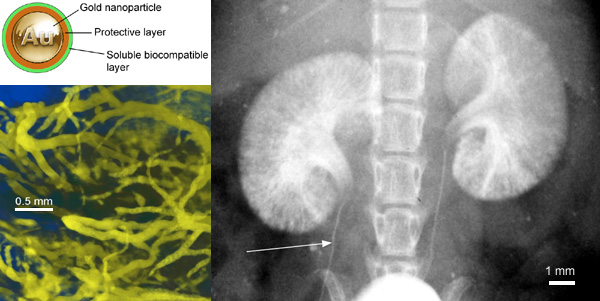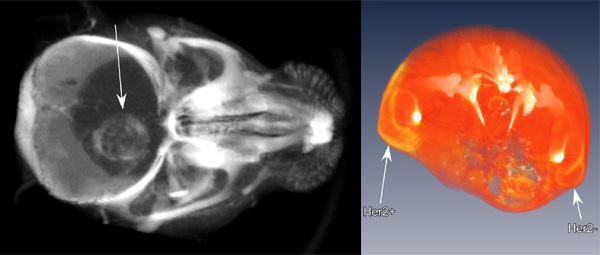We've created a better X-ray contrast agent: AuroVist™.
Using gold nanoparticles instead of iodine, you get five times the contrast, low toxicity and long blood residence times, throughout the clearance pathway.
AuroVist™ is excellent for microCT with animals, kidney imaging, vascular imaging, in vivo vascular casting, and tumor imaging!
X-rays are great for looking inside the body while it is working: they penetrate a long way with relatively little risk, and produce an image that can accurately reveal structures and organs. However, the image is based on absorption, and if there's no difference in X-ray absorption between the organ of interest and the surrounding tissue, it can be just about invisible. How do you fix that? Answer – fill it with something that absorbs much more strongly: a contrast agent. The agent of choice is iodine, and multiply iodinated compounds – usually derivatives of triiodobenzene - make up most of the contrast agents in use today.
But gold also does interesting and useful things with X-rays – in fact, gold absorbs X-rays up to 2.7 times more strongly than iodine (at 100 keV, the absorption cross-section of gold is 5.16 cm2g-1, while that of iodine is 1.94 cm2g-1;). Gold is therefore potentially better than iodine as a contrast agent, and the figure below shows an illustration using solutions of gold nanoparticles and iodine reagents in capillaries:

|
| Imaging of gold vs. iodine reagents in simulated blood vessels (glass capillaries). Polystyrene was used to emulate tissue thickness, typical of a large or obese patient receiving a fluoroscope examination. |
Gold reagents have been relatively expensive, and until now have proven difficult to administer in a biologically compatible form. However, Nanoprobes gold nanoparticle technology changes the game.
Our core technology of coating gold nanoparticles with synthetic, "designer" ligands gives us the tools to make gold nanoparticle reagents which are highly stable under physiological conditions, remarkably non-toxic, and are so soluble in aqueous solutions that they can achieve concentrations as high as 1 g/cm3 or higher.
Their properties also include very low viscosities and osmolalities: this means that they can be administered with minimal trauma, and if necessary, injected into smaller vessels closer to the organ under study than their iodine counterparts.
Gold nanoparticles have another important advantage: size. As it turns out, bigger is better, especially for applications such as microCT of small animals in which long imaging times are needed. Iodinated contrast agents are small molecules, and as a result clear from body very rapidly. This cuts down on imaging time, and a longer imaging time lets you record more data with higher sensitivity and resolution.
 Check out this amazing new video-- Check out this amazing new video--
In vivo MicroCT of mouse
after AuroVist™ 15 injection
|
|
Note very high contrast in blood and heart, with little accumulation in liver. 4 hours after i.v. injection.
AuroVist™ is a revolutionary tool in vascular visualization-- It gives up to 3 times the contrast of iodine, and without the vascular damage!
Created during recent experiments here at the Nanoprobes Labs. |
|
Gold nanoparticles are bigger, so they stick around longer; they can also be prepared in a choice of sizes with very narrow size distributions. Furthermore, the size of an inert reagent like a gold nanoparticle determines not only how quickly it clears from the body, but also its clearance pathway. Hence, by changing the size, we can choose how they clear, and use them to image the organs they pass through on their way out.
This is the technology behind our AuroVist™ product line. AuroVist™ is a highly soluble, non-toxic preparation of gold nanoparticles in a stable, biocompatible form for imaging the vascular system and other organs in animal research and model studies using microCT, CT or mammography instruments. AuroVist™ is available in two particle sizes: 1.9 nm and 15 nm.
Advantages of AuroVist™
over iodine-based X-ray contrast agents:
- Up to 5 times the contrast of standard iodine agents: absorbs 2.7 times more than same weight of iodine at 20 and 100 keV, and can be injected at up to 1.5-fold higher concentrations (up to 800 mg Au/cc).
- Much longer blood residence time than iodine agents (blood half-life is 10 hours for AuroVist™-15 nm). This allows long imaging times and high contrast: ideal for imaging by standard microCT where scan times can be 30 minutes to two hours.
- High contrast throughout the clearance pathway (>4,000 HU initial blood contrast, kidneys >4,000 HU).
- Low toxicity (LD50 >5.0 g Au/kg for AuroVist™-15 nm, LD50 >1.4 g Au/kg for AuroVist™-1.9 nm).
- Low osmolality, even at high concentrations: minimal physiological impact.
- Low viscosity, similar to water; easy to inject with minimal trauma even into small vessels.
 |
(Upper left) Gold nanoparticle with ligand shell showing protective layer to isolate gold from physiological interactions and highly soluble, biocompatible outer layer.
(Lower left) High-resolution microCT with AuroVist™-15 nm: blood vessels in a live mouse around legs and pelvic region after IV injection of AuroVist™-15 nm.
(Right) Kidney imaging, showing how clearance through the kidneys facilitates detailed imaging: Planar X-ray image of kidneys in live mouse after IV injection of AuroVist™-1.9 nm gold nanoparticles. Arrow: 100 µm ureter. |
Applications of AuroVist™:
- MicroCT studies with animal models. The longer blood residence lets you take advantage of long imaging times, so you can use lower concentrations of reagents or improve your contrast.
- Kidney imaging: AuroVist™-1.9 nm clears through the kidneys, and is is ideal for imaging kidney fine structure with high contrast and resolution.
- Vascular imaging: AuroVist™ shows vessels as small as 20 µm.
- In vivo (virtual) vascular casting: now, there is no need to sacrifice animals to achieve complete vascular visualization.
- Tumor imaging: angiogenesis increases the permeability of vasculature in tumors, letting the gold nanoparticles leak out into the tumor where they accumulate.
Tumor imaging with AuroVist™
Two approaches to tumor imaging are illustrated below. On the left, a brain tumor imaged after selective leakage of standard AuroVist™-15 nm – the gold nanoparticle reagent accumulates through vascular leakage alone. On the right, a result from a prototype targeted AuroVist™, in which 15 nm gold particles were linked to Herceptin, a monoclonal antibody which targets HER2, an oncoprotein which is a marker for aggressive malignant behavior in breast cancer. The difference in AuroVist™ accumulation between a HER2-positive and a HER2-negative tumor implanted into the same animal is shown.
 |
| Tumor imaging with AuroVist™:
(Left) Brain tumor in mouse imaged by microCT after intraveneous injection of AuroVist™ 15nm.
(Right) Protoype of a targeted AuroVist™: MicroCT section from mouse bearing Her2-positive (left arrow) and Her2-negative tumors (right arrow) growing in opposite thighs, 20 hours after intraveneous injection of Herceptin-linked AuroVist™-15nm. The reagent preferentially targets the Her2-positive tumor, producing higher contrast. |
- Hainfeld, J. F.; Slatkin, D. N.; Focella, T. M, and Smilowitz, H. M.: Gold nanoparticles: a new X-ray contrast agent. Br. J. Radiol., 79, 248-253 (2006).
- Hainfeld, J. F.; Slatkin, D. N.; Focella, T. M., and Smilowitz, H. M.: In Vivo Vascular Casting. Microsc. Microanal., 11, (Suppl. 2: Proceedings); Price, R.; Kotula, P.; Marko, M.; Scott, J. H.; Vander Voort, G. F.; Nanilova, E.; Mah Lee Ng, M.; Smith, K.; Griffin, P.; Smith, P., and McKernan, S., Eds.; Cambridge University Press, New York, NY, 1216CD (2005).
More information on AuroVist™ X-ray Contrast Agent for MicroCT:
|
Also in this issue:
|